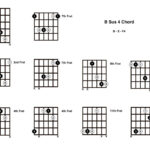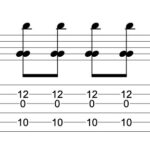Hybrid scales are a secret weapon in the arsenal of advanced guitar improvisers. These unique scales blend elements from different musical modes and scales, creating rich harmonic textures perfect for solos and melodic exploration. Among these, the Mixo blues scale for guitar stands out as a powerful tool for injecting bluesy flavor into your playing, particularly over dominant 7th chords.
This exciting scale is a fusion of the Mixolydian mode and the blues scale. By combining these two foundational elements, the Mixolydian blues hybrid unlocks a distinctive sound that’s essential for crafting those compelling major-minor blues licks you hear in countless guitar solos. Let’s dive into how this scale is constructed and how you can use it to elevate your guitar playing.
What is the Mixolydian Blues Hybrid Scale?
As the name suggests, the Mixolydian blues hybrid scale is born from layering the blues scale (1-♭3-4-♭5-5-♭7) onto the Mixolydian mode (1-2-3-4-5-6-♭7). Figure 1 illustrates this combination in the 4th position of the key of A.
The result is a nine-note scale with the formula: 1-2-♭3-3-4-♭5-5-6-♭7. This expanded scale is rich with possibilities, incorporating both major (3rd) and minor (♭3rd, ♭7th) tonalities, along with characteristic blues notes (♭5th) and chromatic color (spanning from the 2nd to the 5th degrees). This unique blend makes it exceptionally well-suited for adding depth and color to dominant 7th chords and Mixolydian-based progressions.
If you were to play the A Mixolydian blues hybrid scale pattern shown in FIGURE 1 as you would a standard diatonic scale, you might find it sounds a bit unconventional. This is because it’s a synthetic scale, designed for a specific purpose: to seamlessly blend blues scale phrases with Mixolydian lines, and vice versa.
FIGURE 1
This fusion creates a captivating major/minor interplay – a true “Mixo-blues” sound. To hear this concept in action, explore the modern blues lick in FIGURE 2. Pay close attention to the interplay between the minor 3rd and major 3rd (C-C#), the slide from minor 3rd to major 2nd (C-B), and the strategic use of the F# (major 6th) notes. Use this example as inspiration to revisit your favorite A blues scale licks and experiment with incorporating C#, F#, or B notes to add that Mixolydian blues flavor.
FIGURE 2
Applying the Mixolydian Blues Scale in Different Musical Styles
The versatility of the Mixolydian blues hybrid scale shines across various genres. Consider the popular E7#9 chord, a staple in blues-rock and funk. This chord, being dominant with a sharp 9th (F##, enharmonically G), creates a perfect canvas for the E Mixolydian blues hybrid scale. The scale and chord beautifully complement each other, as demonstrated in the funky blues-rock example in FIGURE 3.
FIGURE 3
The Mixolydian blues hybrid scale is not confined to blues and rock; it also finds a place in jazz. It’s often found at the heart of bebop lines, adding a unique color to jazz improvisation. FIGURE 4 showcases how the C Mixolydian blues hybrid scale interacts with a C13 chord, providing a cool framework for navigating chord tones in a jazzy context.
FIGURE 4
Even in hard rock, known for its intensity and virtuosity, the Mixolydian blues hybrid scale proves its worth. Guitar heroes like Eddie Van Halen and Angus Young have incorporated this scale to create fiery, cadenza-like licks. FIGURE 5 presents a hard rock example in A, using the A Mixolydian blues hybrid scale against an ambiguous A5 power chord backdrop, typical of the genre.
FIGURE 5
Unlocking Further Scales Within
Interestingly, the Mixolydian blues hybrid scale contains other familiar scales within it. By removing certain notes, you can uncover the Dorian mode (1-2-♭3-4-5-6-♭7), the major pentatonic scale (1-2-3-5-6), and the minor pentatonic scale (1-♭3-4-5-♭7), all hiding within its nine notes. This inherent versatility means the Mixolydian blues hybrid scale, when used thoughtfully, can be applied in a remarkably wide range of musical situations.
Conclusion: Embrace the Mixo-Blues Sound
The Mixolydian blues hybrid scale is a powerful and versatile tool for any guitarist looking to expand their improvisational vocabulary and add a unique bluesy edge to their playing. Whether you’re playing blues, rock, jazz, or even funk, this scale offers a wealth of possibilities for creating compelling solos and fills. So, take these patterns, experiment with them in different keys and musical contexts, and start crafting your own signature “Mixo-bluesian” licks today!


